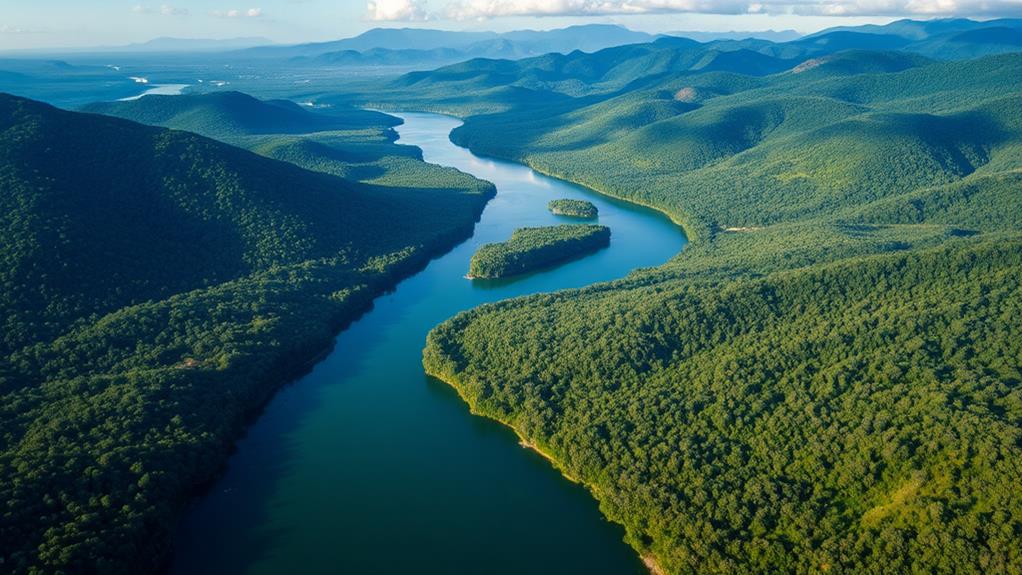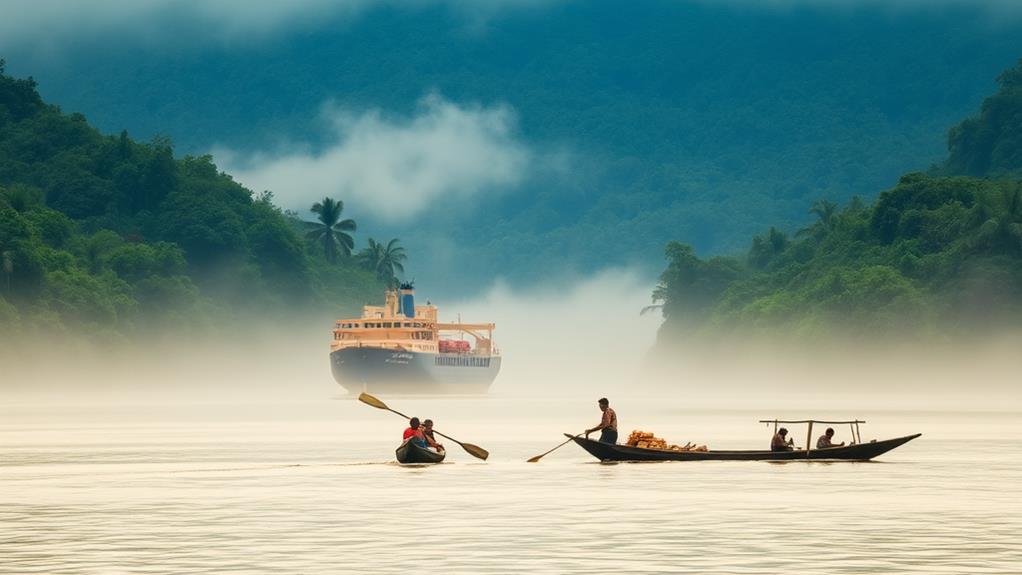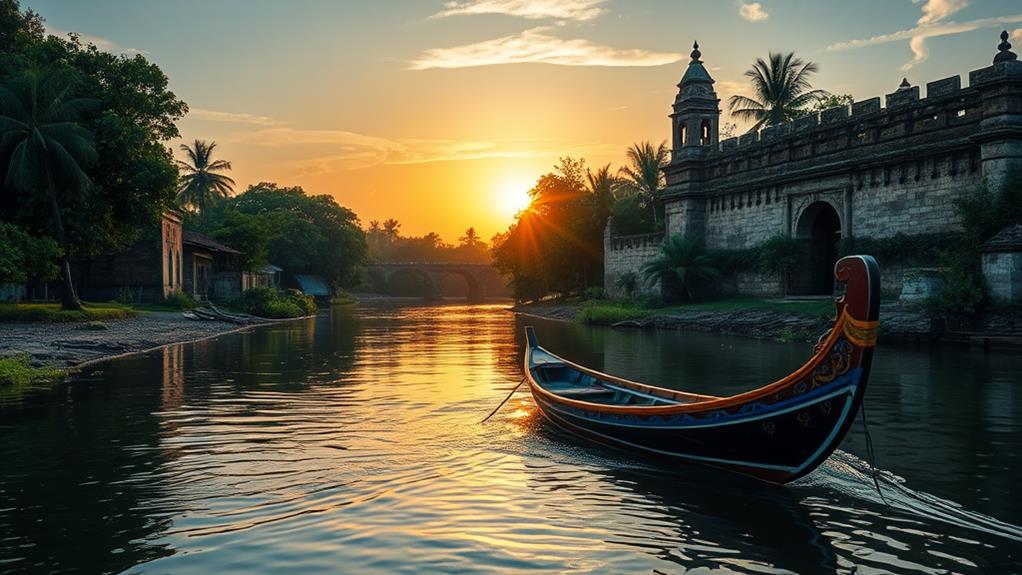The Cagayan River spans 505 kilometers, making it the longest river in the Philippines. This significant waterway serves as a natural boundary, economic artery, and cultural hub, supporting communities, biodiversity, and the nation's history.
Agriculture thrives along its banks, with the river providing irrigation for crops and supporting the livelihoods of local farmers. As a vital transportation route, the river facilitates the movement of goods and people, connecting rural areas to urban centers.
Recreational activities abound, with opportunities for fishing, boating, and swimming. The river's cultural significance is rooted in its rich heritage, shaped by indigenous communities and settlers.
Unique flora and fauna inhabit the river's ecosystem, including the Philippine crocodile, monitor lizards, and various fish species. As you explore the Cagayan River, you'll uncover the complexities and wonders of this majestic waterway.
Geographic Significance

The Cagayan River is the longest river in the Philippines, stretching approximately 505 kilometers (314 miles) through the heart of Luzon. This extensive course makes it a vital geographic feature, serving as a natural boundary between Isabela and Nueva Vizcaya provinces. The Cagayan River also plays a crucial role in the transportation of goods and people, with several towns and cities relying on its waters for trade and commerce. However, like many rivers around the world, it faces environmental challenges such as pollution and deforestation. The pasig river revival efforts serve as a reminder of the importance of preserving and protecting our natural waterways for future generations.
The river's fertile valley supports significant agricultural activities, such as rice and tobacco cultivation, which are crucial to the region's economy. The Cagayan Valley region relies heavily on the river's resources, making it a lifeline for the communities it touches.
The river's geographical significance is enhanced by its multiple tributaries, including the Magat, Chico, Ilagan, and Mallig rivers. These tributaries not only contribute to the river's hydrological significance but also add to its ecological diversity, supporting a wide range of plant and animal species.
Hydrological Characteristics
The Cagayan River's hydrological profile is shaped by its significant length and elevation changes. Its headwaters originate in the Caraballo Mountains at an elevation of 1,524 meters (5,000 feet) and flow into the Babuyan Channel at sea level. This variation in elevation influences its flow dynamics and ecosystem.
The river's major tributaries significantly contribute to its hydrology. For instance, the Chico, Magat, and Ilagan Rivers are notable tributaries, with the Magat River being the largest.
Seasonal flooding is a significant hydrological characteristic, particularly during the monsoon season from May to October. During this time, the average annual rainfall ranges between 1,000 mm (39 in) to 3,000 mm (120 in).
Flood management efforts regulate water flow during heavy rainfall. The operation of the Magat Dam helps mitigate flooding risks. Peak release rates can reach up to 5,073 cubic meters per second.
Additionally, the river's hydrological profile is influenced by its annual discharge, with the Magat River contributing 9,808 million cubic meters.
Economic and Cultural Impact

Economic Impact
The Cagayan River supports the Philippines' food security through its thriving agricultural industry. Over 200,000 hectares of rice fields and extensive corn cultivation in the river's valley have earned Isabela the title of the "corn capital" of the country. Major crops like rice, corn, tobacco, and fruits are cultivated along the river, significantly contributing to the local economy.
Cultural Significance
The Cagayan River isn't only an economic lifeline but also a cultural hub. Indigenous communities, such as the Ibanag and Gaddang tribes, rely on the river for sustenance and cultural practices.
With a combined population of approximately 2 million in the surrounding provinces, these communities are an integral part of the region's cultural fabric. The river serves as a vital transportation route, facilitating trade and connectivity between towns, which enhances economic activities in the Cagayan Valley region.
Cultural events like bancarera (boat racing) and fluvial parades celebrate the river's significance, attracting local and tourist participation, especially during the festive month of July.
Flora and Fauna Diversity
The Cagayan River: A Sanctuary for Unique Flora and Fauna
The Cagayan River in the Philippines is home to a diverse range of flora and fauna, many of which are found nowhere else in the world. Two endangered endemic species, the Luzon bleeding-heart pigeon and the Philippine eagle, call the Cagayan River home. These species aren't only unique to the river but also play a vital role in maintaining the ecosystem's delicate balance.
The River's Ecosystem Supports a Variety of Species
The ludong fish, for example, migrates downstream to release eggs at the river mouth, supporting the ecosystem's delicate balance.
Lush landscapes and forests that line the riverbanks provide habitats for numerous aquatic and terrestrial species. These habitats are crucial for the survival of various species that depend on the river.
Seasonal Flooding Nourishes the Ecosystem
Seasonal flooding brings nutrient-rich sediments, fostering the growth of diverse flora in the surrounding wetlands and agricultural areas. This natural process is essential for maintaining the river's ecosystem and supporting the growth of diverse flora and fauna.
Conservation Efforts Are Crucial
The Cagayan River's ecosystem faces threats from pollution, deforestation, and unsustainable fishing practices.
By protecting this ecosystem, we can ensure the long-term survival of the Cagayan River's unique and fascinating flora and fauna diversity. It's essential to prioritize conservation efforts to preserve the river's ecosystem and the species that call it home.
Environmental Concerns and Management

The Cagayan River faces significant environmental concerns that threaten its delicate ecosystem.
Pollution is a major issue, primarily caused by agricultural runoff and urban development, which affects water quality and local ecosystems. For instance, the use of chemical fertilizers in farming leads to the release of toxic substances into the river, harming aquatic life.
Deforestation in the Sierra Madre mountain range exacerbates environmental problems. The removal of trees leads to soil erosion, reducing the land's ability to absorb water, and increases the risk of flooding. This, in turn, affects the river's natural flow patterns and endangers the ecosystems that depend on it.
Climate change has altered the river's flow patterns, resulting in increased flooding risks. During the monsoon season, the river's water levels rise, causing substantial economic losses. To mitigate this, initiatives like the Magat Dam have been implemented to manage water levels effectively.
Conservation efforts are essential to protect the river's biodiversity. The Cagayan River is home to endemic species such as the Luzon bleeding-heart pigeon and the Philippine eagle. To preserve these species and improve water quality, responsible management and conservation of the river's ecosystem are crucial.
Recreational Activities and Tourism
Experience Adventure on the Cagayan River
The Cagayan River, the longest river in the Philippines, offers a diverse range of recreational activities catering to different interests and skill levels.
Thrilling Events and Activities
Participate in exciting events like bancarera (boat racing) and fluvial parades, especially during July when local festivities are in full swing.
Whitewater Rafting Options
Choose from five certified companies that provide whitewater rafting services, ensuring your safety while navigating the river's rapids.
Relaxed River Experiences
Opt for kayaking, river trailing, swimming, or ferry touring for a more relaxed experience amidst the scenic landscapes.
Canoeing or river tubing are also available for a laid-back adventure.
Safety First
Rest assured that the region's tourism infrastructure prioritizes your safety, with measures like face masks and social distancing protocols in place.
Can Cruising Along the Pasig River Provide a Similar Experience to the Cagayan River?
Cruising along the Pasig River offers a unique experience that may not be similar to traveling along the Cagayan River. However, reviving the pasig river through eco-friendly initiatives may create a more pleasurable experience for locals and tourists alike, allowing for a renewed appreciation of urban waterways.
Historical and Cultural Heritage

The Cagayan River's cultural fabric is rich in history and cultural heritage. This heritage has been shaped by the lives of indigenous communities and settlers who've lived along the river.
The river has served as a vital transportation route for trade and migration, facilitating cultural exchanges among indigenous populations in the region.
The river has influenced the development of regional identities, particularly among indigenous communities such as the Ibanag and Gaddang tribes.
These tribes rely on the river's resources for sustenance and traditional practices. For example, the Ibanag people have traditionally used the river for fishing and rice cultivation, while the Gaddang tribe has used it for irrigation and crop rotation.
Historical events along the Cagayan River have shaped the livelihoods and settlement patterns of local communities. For instance, the river's role in agricultural development has led to the growth of towns and cities along its banks.
The river's cultural significance is highlighted through various festivals and events, such as the annual fluvial parades that celebrate local traditions and reinforce community ties. These events showcase the river's importance in the daily lives of the people who live along its banks.
Frequently Asked Questions
Is the Cagayan River the Longest River in the Philippines?
The Cagayan River is the longest river in the Philippines, stretching approximately 505 kilometers.
This extensive length supports a vast ecosystem, with significant tributaries like the Magat, Chico, and Ilagan rivers.
What Is the Longest Flowing River in the Philippines?
The Cagayan River is the longest flowing river in the Philippines, stretching approximately 505 kilometers from its source in the Caraballo Mountains to its mouth in the Babuyan Channel.
This vital watercourse supports agriculture, river tourism, and conservation efforts, serving as a lifeline for communities along its banks.
Its length is crucial for understanding river ecosystems, cultural significance, and local wildlife.
Why Is the Cagayan River Important?
The Cagayan River is ecologically significant because it supports a wide range of flora and fauna, including endemic species. This is evident in the diverse wildlife that inhabits the river and its surrounding areas, such as the Philippine crocodile and the Philippine cockatoo.
The river also holds cultural significance, having shaped the development of local communities along its banks. For example, the river has provided a means of transportation, food, and livelihood for the people living in the region.
Economically, the Cagayan River irrigates vast areas of rice and corn fields, making it a vital source of food for the region.
It also supports local economies by providing a means of livelihood for people engaged in fishing, agriculture, and other industries.
Furthermore, the river plays a vital role in flood management by regulating the flow of water and preventing floods in the surrounding areas.
It also supports biodiversity conservation by providing a habitat for various plant and animal species.
What Is the Old Name of Cagayan De Oro River?
The old name of the Cagayan de Oro River was Cagayan de Misamis.
This name reflects the river's historical ties to the Misamis region.
The name highlights the river's cultural significance and Indigenous roots, which are important to understanding the region's history.